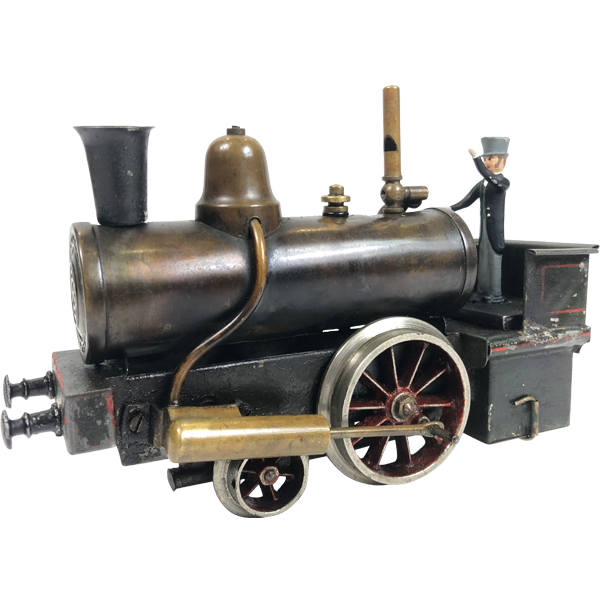
- DE
- EN
- FR


If you look around here, you wouldn't guess that this was once an elderly lady's bedroom. Now it's the ideal place to show you the diversity of Bing's railways.
If you look up, you will discover transparent glass tubes. Here, you can see the technology of the locomotives excellently from below.
Bing used the drive technologies clockwork, steam and electricity.
For the clockwork drive, you have to wind up a spring mechanism to get the locomotive running. This is a child-friendly and safe drive.
It's a different story with the steam-powered locomotive: A spirit burner heats the water in the boiler until steam is produced. The steam, the fire and the hissing and whistling noises made this look wonderfully realistic. Nevertheless, the burning spirit also made it very dangerous and more of a father's toy where the children were merely spectators.
The locomotive and the wagon could be illuminated and the speed could be controlled. They were available with high-voltage and low-voltage drive.
The diversity of Bing's railways was not limited to the drive. There were also countless visual variations. Bing was an international company and every country had its own real-life models for its toy trains. A train that resembled the Mitropa or the Balkan train sold better regionally than any other train.
Bing had showrooms in many cities around the world. They presented trains that corresponded to the respective railway line of the country in terms of colours and inscriptions. For example, Bing had the lines of England, America, Canada, France and Germany. In the middle display case on the left you can see the different gauges of the railways. The very first locomotives ran on the ground, still without rails. This was followed by grooves pressed into sheet metal as a substitute for rails.
The first real rails and thus the track gauges were quite large, as the clockwork and steam technology took up a lot of space in the locomotives. Accordingly, the space required in the men's or children's room at home was large: The gauge IV with 75mm required a radius of 1.85m at Bing. Later, rails in smaller gauges followed. In 1922, Bing engineers finally developed the Bing tabletop railway with 16.5mm tracks, which corresponds to today's H0 gauge. These gauges required less space and were affordable for smaller budgets.
If you now take a look to the right, you will see the origin of this museum in the display case at the back left of the wall:
"It was 1996 when I was strolling through the flea market in Wiesbaden with my wife Marion. I saw a pretty tin railway. I would have liked to buy it, but the seller said it cost 380 D-marks. That was much more than I had expected. He told me about the Bing company and that this little locomotive was a toy antique. Well - it was the beginning of a very big fascination and passion, because my wife Marion sent me a few stalls further, negotiated with the seller and shortly afterwards gave me exactly this locomotive. This flea market discovery gave rise to the "Uwe Groll" collection that you are currently looking at here in the Toy House. It is the largest and most diverse collection of Bing toys and household goods in the world."